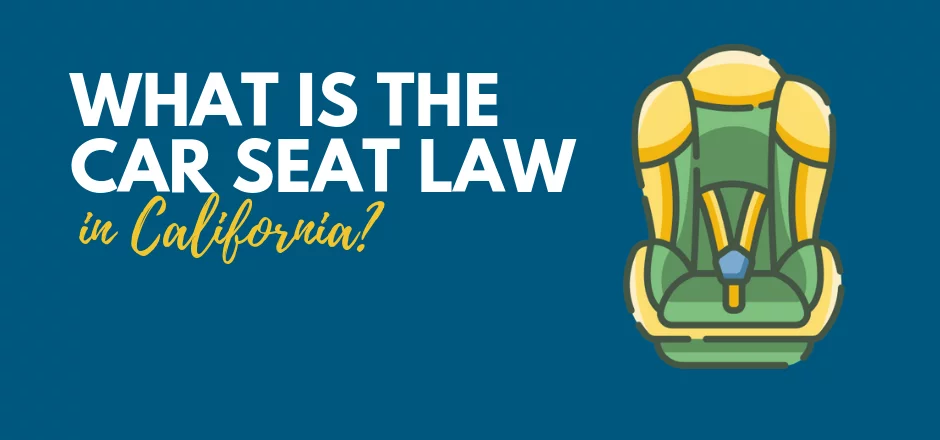What Is the Car Seat Law in California?
If you live in California and have children, you may have a few questions regarding car seat laws. So, what is the car seat law in California and how long does it apply?
In this article, we’ll take a closer look at these questions so you have a better understanding of the law.
What Is the Car Seat Law in California?
You get in the car, strap your kids in, and hit the road on a regular basis. While driving seems second nature to you at this point in your life, accidents can and do happen with no regard to whether or not there are children in the car.
According to The New York Times, approximately 2,885 children were killed in car accidents between 2010 and 2014. At least 40 percent of those deaths were caused because the children involved were not properly restrained. Fifteen percent more died because they were in the front seat and should not have been.
What is the carseat law in California?
In the state of California, children falling into specific categories must ride in a car seat or booster seat at all times. However, many parents fail to use car seats correctly, increasing the risk of damage or harm in an accident. This post will explore California’s regulatory system. It will also point out common risk factors to help you drive safely with infants, toddlers, and children on board.
About the Regulatory System for Car Seats
Car seat laws vary from state to state but tend to be pretty cut and dry. California’s law states that any child under the age of two needs to be in the back seat of the car, properly restrained in a rear-facing car seat. There are no exceptions that allow for a baby to not be in a rear-facing car seat, but there are a few exceptions that would allow for a baby to be in the front of the car instead of the back. These include:
- Trucks or small cars that do not have back seats
- The back seat is completely occupied by other young children
- Using the back seat might be dangerous, such as if the seat is broken or loose, or if the seatbelt is broken
You are never allowed to place a baby in the front seat if there is an airbag on the passenger side. Some newer cars have functionality that allows you to turn off passenger side airbags when children are present.
The state of California offers guidelines for switching an infant over the age of two to a front-facing car seat. They recommend following what is known as the 4-40-40 rule. They are looking for a child to be at least 4 years old, weight at least 40 pounds, and/or be at least 40 inches tall. These guidelines were put in place with the knowledge that children grow at different rates, but the average child will not reach these numbers until around age 4 years old.
Car Seat Safety
Car seats are designed to keep small children safe, but user error can still have devastating consequences. When using a car seat, you’ll want to keep the following in mind:
- Car seats do expire. Wear and tear, exposure to heat and cold, and other factors can wear the materials out. Know your seat expiration date and replace it when necessary.
- Make sure your car seat is properly installed. You have the option to use the car’s seat belt or the seat anchors. Choose one or the other. Do not attempt to use both to tether the seat to the car.
- Front-facing car seats should have five-point harnesses to properly secure your child at all times.
- Children in car seats should not wear bulky coats. Heat your car up in the winter and take your child’s coat off before buckling them in. Bulky coats create space that prevent the straps from staying snug. This means your child could slip out of the seat in the event of an impact.
- Never travel without your child’s car seat, even on vacation. Take it on taxi rides, bus rides, train rides, and anywhere else where your child should be restrained.
What About Booster Seats?
Once a child has outgrown a forward-facing car seat, you can switch to a booster seat. California law states that a child has to be in a car seat or a booster seat until they turn eight. The only exception is if your child is 4’9” before their eighth birthday. Otherwise, the recommendation is that a child should stay in a booster seat until they reach that height, even if they continue using it up until the age of 12.
Seatbelt Laws
Ok, so your child has grown out of the booster seat. What’s next? You still have to follow the law in terms of how the belt fits on your child. Seatbelts that do not fit properly can cause serious internal injury in the event of an accident, causing damage to the intestines, spleen, liver, and even the spine.
The lap belt has to rest on the lower hip/upper thighs. The chest strap has to properly lay across the chest, in the center without cutting into the neck. Your child needs to be tall enough sit agains the back of the seat and their knees have to bend over the edge.. A child that is of proper height should not have trouble with these guidelines.
All of that said, your child also needs to be physically and mentally capable of remaining properly seated in the seatbelt for the entirety of your trip, no matter how far you are traveling. If your child doesn’t meet any of the above guidelines for behavior or a proper fit, you should continue to use a booster seat.
While your little ones want to be like you, or like the “big kids” they see elsewhere, resist the urge to allow them ditch their booster seats or to sit in the front seat. Don’t argue or allow your kids to wear you down. Be firm in the fact that they are simply not allowed to be upfront. Children should really stay in the back seat until they are at least 13 years of age. Even older children should stay in the back seat if they don’t meet the height and weight recommendations to be near your car’s front airbags.
Remember to set a good example for all of the children in your car. All passengers, including adults in the front and back seats, should wear their seatbelts at all times. Start building safe car habits at an early age and your children will grow up to continue those practices in their teenage and adult years. When riding in a car, safety should always come first.
FAQ About Car Seats
Automobile accidents are the leading cause of death and injury for all children. Obey the law and graduate your child from car seat to booster seat to seat belt slowly.
Children under 2 years of age should ride in a rear-facing car seat until they weigh 40+ pounds or are 40+ inches tall.
Not installing the car seat tight enough. Graduating a child from car seat to booster or seat belt too quickly.
Rear-facing car seats are designed to distribute crash forces, providing support for the head, neck, and spine.
Seat belts are not designed for small children and may actually cause injury or death during an automobile crash.
No.
$100 fine for the first offense, $250 fine for the second offense. http://leginfo.legislature.ca.gov/faces/codes_displaySection.xhtml?lawCode=VEH§ionNum=27360.6.
Conclusion
Now that you know more about the car seat law in California, you can proceed with caution to ensure your child is safe in your automobile. As mentioned, automobile accidents are the leading cause of death for children, so it’s important to obey the law and graduate your child from car seat slowly.
Are you in search for a certified attorney to represent you?
Let us help you find one today!

